
Buxton is a spa town in the Borough of High Peak, Derbyshire, in the East Midlands region of England. It is England's highest market town, sited at some 1,000 feet (300 m) above sea level. It lies close to Cheshire to the west and Staffordshire to the south, on the edge of the Peak District National Park. In 1974, the municipal borough merged with other nearby boroughs, including Glossop, to form the local government district and borough of High Peak.

Chesterfield is a market and industrial town in the county of Derbyshire, England. It is 24 miles (39 km) north of Derby and 11 miles (18 km) south of Sheffield at the confluence of the Rivers Rother and Hipper. In 2011, the built-up-area subdivision had a population of 88,483, making it the second-largest settlement in Derbyshire, after Derby. The wider Borough of Chesterfield had a population of 103,569 in the 2021 Census. In 2021, the town itself had a population of 76,402.
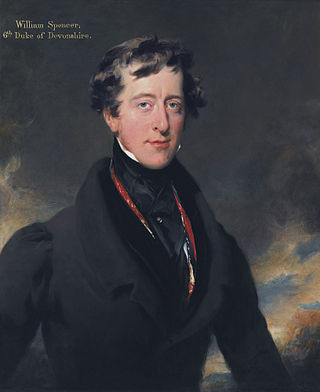
William George Spencer Cavendish, 6th Duke of Devonshire,, styled Marquess of Hartington until 1811, was an English peer, courtier and Whig politician. Known as the "Bachelor Duke", he served as Lord Chamberlain from 1827 to 1828 and again from 1830 to 1834. The Cavendish banana is named after him.

Derby Museum and Art Gallery is a museum and art gallery in Derby, England. It was established in 1879, along with Derby Central Library, in a new building designed by Richard Knill Freeman and given to Derby by Michael Thomas Bass. The collection includes a gallery displaying many paintings by Joseph Wright of Derby; there is also a large display of Royal Crown Derby and other porcelain from Derby and the surrounding area. Further displays include archaeology, natural history, geology, military collections and world cultures. The Art Gallery was opened in 1882.

The University of Derby, formerly known as Derby College, is a public university in the city of Derby, England. It traces its history back to the establishment of the Derby Diocesan Institution for the Training of Schoolmistresses in 1851. It gained university status in 1992.

Sir Henry Howe Bemrose was a British printer and publisher, as well as mayor and later Conservative Member of Parliament for Derby.

Stirling Smith Art Gallery and Museum, formerly The Smith Institute, is an art and local history museum in Stirling, Scotland. The museum was founded in 1874 at the bequest of artist Thomas Stuart Smith.

Saint Alkmund's Church was a Victorian church, which stood in a Georgian square between Bridgegate and Queen Street in Derby; this was the only Georgian square in the city. The church and its yard were demolished in 1968 for construction of a road to improve traffic flow.

White Watson was an early English geologist, sculptor, stonemason and carver, marble-worker and mineral dealer. In common with many learned people of his time, he was skilled in a number of artistic and scientific areas, becoming a writer, poet, journalist, teacher, botanist and gardener as well as a geologist and mineralogist. He kept extensive diaries and sketchbooks of his observations on geology, fossils and minerals, flora and fauna, and published a small but significant and influential number of geological papers and catalogues. As an artist he was well known locally for his silhouettes, both on paper and as marble inlays.
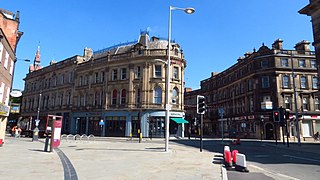
Derby is a city and unitary authority area on the River Derwent in Derbyshire, England. Derbyshire is named after Derby, which was its original county town. As a unitary authority, Derby is administratively independent from Derbyshire County Council. The population of Derby is 263,490 (2022).
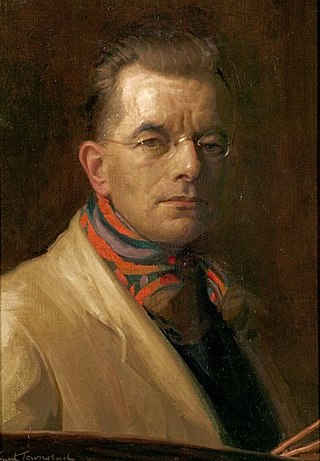
Ernest Townsend was a British portraitist from Derby.
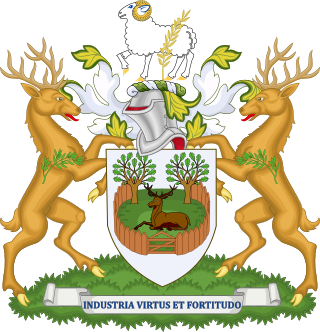
Derby City Council is the local authority for the city of Derby, in the ceremonial county of Derbyshire in the East Midlands region of England. Derby has had a council from medieval times, which has been reformed on numerous occasions. Since 1997 the council has been a unitary authority, being a district council which also performs the functions of a county council. Since 2024 the council has been a member of the East Midlands Combined County Authority.

The Derby Philosophical Society was a club for gentlemen in Derby founded in 1783 by Erasmus Darwin. The club had many notable members and also offered the first institutional library in Derby that was available to some section of the public.

The three Archdeacons in the Diocese of Derby are senior ecclesiastical officers in the Church of England Diocese of Derby. Each archdeacon has responsibility for church buildings and clergy discipline in her/his respective archdeaconry.
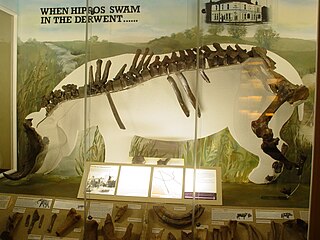
The Allenton Hippo is a hippopotamus skeleton that was found in Allenton, Derby, England, in 1895. The skeleton is exhibited in Derby Museum and Art Gallery and is 3 metres (9.8 ft) in length. It is celebrated today in a sculpture near to where the skeleton was discovered.

Ashford Black Marble is the name given to a dark limestone, quarried from mines near Ashford-in-the-Water, in Derbyshire, England. Once cut, turned and polished, its shiny black surface is highly decorative. Ashford Black Marble is a very fine-grained sedimentary rock, and is not a true marble in the geological sense. It can be cut and inlaid with other decorative stones and minerals, using a technique known as pietra dura.
The following is a timeline of the history of the city of Derby, England.

The Derby Assembly Rooms was an events venue in the English city of Derby. There have been three iterations of the Derby Assembly Rooms, with the last two on the same site. The first was opened in 1714 in Full Street, but soon proved inadequate. The second was built in 1763 on Market Place and was used until it was damaged by a fire in 1963. The third was built in 1977 and used until it too was damaged in a fire in 2014.


















